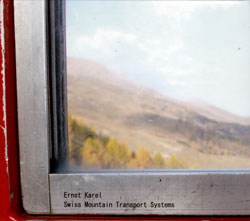
With this release, phonographer/musician Ernst Karel continues his series of magnificently detailed field recordings of fascinating subjects. With Heard Laboratories (and/OAR 2010) his subjects were part of Big Science, while this time the locales are more municipal (or, perhaps, recreational). Once again, the recordings are more than mere sound catalogs or curiosities. Karel's ear for the aesthetic, the interesting, as well as matters compositional, is a crucial ingredient here.
It is easy to see why Karel chose these devices as a field recording source � the elements of motion and travel are important to the effect these recordings produce. The progress of the vehicles through various mechanical segments and external environments combines an unmistakable sense of drama with the familiar, comfortable feeling of being en route. The first track, for example, was recorded inside an eight-seat gondola in Flumserberg, St. Gallen. As it cruises along its journey, a quiet mechanical drone sets the fundamental backdrop. Against this, acoustic events ebb and flow. Some are sudden and stentorian, as when it sounds like the gondola hits a set of rollers on the line. Others are more subtle, such as gusts of air and passing birds. And, as a jaunt along the gondola's itinerary, the clip also has a clear beginning and resolution. It is a found symphony that would seem to have written itself, if not for our awareness of Karel's adeptness in choosing and sampling his sources.
Not all of the tracks create such a blur between the phonographic and the musical (to pretend, for the moment, that those categories are a separable). Track two has to be taken on its own terms. It features not only the mechanical sounds of a funicular (a cliff railway tram) but also the noises of its passengers. Contrast, perhaps, is at the fore. The grunts, chuckles, and bits of conversations of the travelers pull the listener into a familiar social setting � that of transportation in close quarters with others. It is therefore striking, in retrospect, how the mechanical sounds in the middle of the ride seem to subvert this sense of the mundane. The listener is lulled away by their hypnotic patterns, and the quiet of the passengers suggests that they were too.
In fact, a recurring theme � if one wants to call it that � in these recordings may be the contrast between the relatively placid atmospheres of travel itself versus the aural jostle found at launch and landing. Track three brings this out in stark relief. The listener will need a responsive set of headphones or speakers to pick up the minimalist burbling of a ride on the six-seat gondola near Aletsch glacier. At the stops along the way, though, the metallic clangs, whacks, thumps, etc. resonate within a cavernous soundscape. If not for the phonographic verit� of it all, one might be tempted to suspect some underlying symbolism.
There really is quite a bit of variety in these recordings, and the tracks manage to pique both intellectual interests and aesthetic ones. Although I have not tried it myself, one can easily imagine the reaction of someone to whom these recordings are described ("How is that music?") might contrast that of someone who walks in on the sublime drones found on track 6, a recording of a four-seat aerial tramway ("Oh, who is that? Is that the new ___?"). Whatever Ernst Karel might have to say about the Art question in a manifesto, Swiss Mountain Transport Systems provides ample excuse to merely sidestep the question. Some of us simply like listening for its own sake, and there is much here to reward that pursuit.
Comments and Feedback:
|



